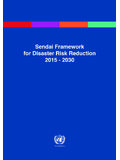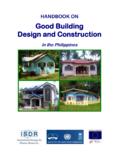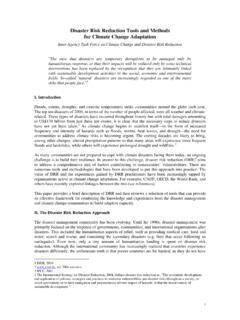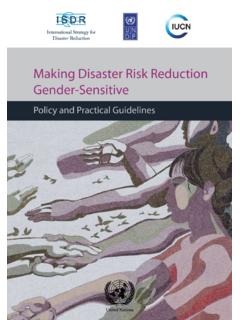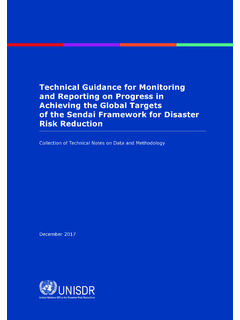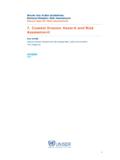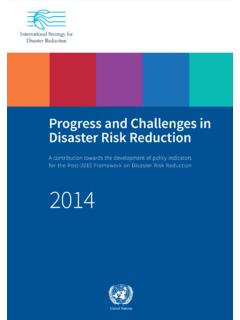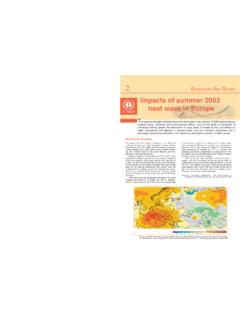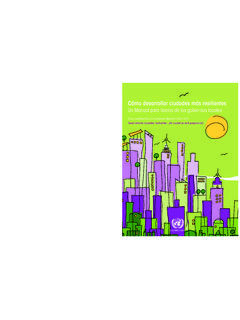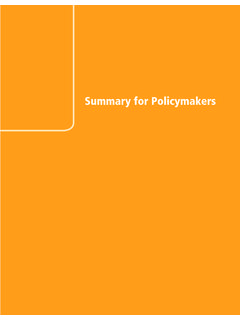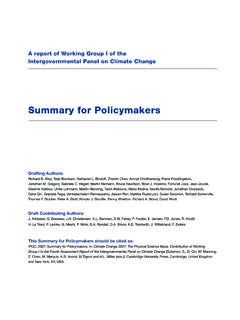Transcription of Climate Change and Disaster Risk Reduction - …
1 ISDRB riefing Note01 Climate Change and Disaster Risk ReductionClimate Change and Disaster risk Reduction are closely linked. More extreme weather events in future are likely to increase the number and scale of disasters, while at the same time, the existing methods and tools of Disaster risk Reduction provide powerful capacities for adaptation to Climate Change . This Briefing Note, prepared by the secretariat of the United Nations International Strategy for Disaster Reduction Secretariat (UNISDR), outlines the nature and significance of Climate Change for Disaster risk, as well as the main perspectives and approaches of Disaster risk Reduction and how they can support adaptation strategies. It is aimed at experts and practitioners as well as non-specialists such as teachers and students, journalists and the interested , September 2008 Weather, Climate and Climate changeDefining Climate changeFor most people, the expression Climate Change means the alteration of the world s Climate that we humans are causing, through fossil fuel burning, clearing forests and other practices that increase the concentration of greenhouse gases (GHG)1 in the atmosphere.
2 This is in line with the official definition by the United Nations Framework Convention on Climate Change (UNFCCC) that Climate Change is the Change that can be attributed directly or indirectly to human activity that alters the composition of the global atmosphere and which is in addition to natural Climate variability observed over comparable time periods .2 However, scientists often use the term for any Change in the Climate , whether arising naturally or from human causes. In particular, the Intergovernmental Panel on Climate Change (IPCC) defines Climate Change as a Change in the state of the Climate that can be identified .. by changes in the mean and / or the variability of its properties, and that persists for an extended period, typically decades or longer .3 Each of these two definitions is relevant and important to keep in Greenhouse gases (GHGs) are those gaseous constituents of the atmosphere, both natural and anthropogenic, that absorb and emit radiation at specific wavelengths within the spectrum of thermal infrared radiation emitted by the Earth s surface, the atmosphere itself, and by clouds.
3 The primary greenhouse gases include H2O, CO2, N2O, CH4 and O3. IPCC Fourth Assessment Report, Working Group I, Glossary of Terms: UNFCCC Article 1, Definitions: IPCC Fourth Assessment Report, Working Group I, Glossary of Terms: Nations2 Briefing Note 01 Climate Change and Disaster Risk ReductionWeather and climateWeather is the set of meteorological conditions wind, rain, snow, sunshine, temperature, etc. at a particular time and place. By contrast, the term Climate describes the overall long-term characteristics of the weather experienced at a place. For example, Singapore, in the tropics, has a hot wet Climate , while continental Mongolia always has cold winters. The ecosystems, agriculture, livelihoods and settlements of a region are very dependent on its Climate therefore can be thought of as a long-term summary of weather conditions, taking account of the average conditions as well as the variability of these conditions.
4 The fluctuations that occur from year to year, and the statistics of extreme conditions such as severe storms or unusually hot seasons, are part of the climatic variability. Some slowly changing climatic phenomena can last for whole seasons or even years; the best known of these is the El Ni o Since the atmosphere connects all weather systems and all climates, it is sometimes useful to describe the atmosphere, oceans and Earth surface as the global Climate system .5 Because the Climate system is in a constant state of flux and has always exhibited natural fluctuations and extreme conditions, it is not possible to argue that any single extreme event is attributable to Climate Change . Only after a sufficient period and with hundreds of extreme events recorded can scientists determine if a specific event is within normal historical variation or is due to some other cause such as Climate IPCC Fourth Assessment Report, Working Group I, Glossary of Terms: The Climate system is the highly complex system consisting of five major components: the atmosphere, the hydrosphere, the cryosphere, the land surface and the biosphere, and the interactions between them.
5 IPCC Fourth Assessment Report, Working Group I, Glossary of Terms: causes Climate changeThe Earth s Climate has varied considerably in the past, as shown by the geological evidence of ice ages and sea-level changes, and by the records of human history over many hundreds of years. The causes of past changes are not always clear but are generally known to be related to changes in ocean currents, solar activity, volcanic eruptions and other natural The difference now is that global temperatures have risen unusually rapidly over the last few decades. There is strong evidence of increases in average global air and ocean temperatures, widespread melting of snow and ice, and rising average global sea levels. The IPCC Fourth Assessment Report concludes that the global warming is unequivocal. Atmosphere and ocean temperatures are higher than they have been at any other time during at least the past five centuries, and probably for more than a Scientists have long known that the atmosphere s greenhouse gases act as a blanket which traps incoming solar energy and keeps the Earth s surface warmer than it otherwise would be, and that an increase in atmospheric greenhouse gases would lead to additional warming.
6 The current concentration of greenhouse gases in the atmosphere is now the highest it has been for the past 500,000 years, having grown by 70% between 1970 and 2004 alone, and having reached this level exceptionally While there has been some controversy in the past, it is now widely accepted that human activities, in particular fossil fuel use and changing land-uses, are the dominant factor in this growth and are responsible for most of the warming observed over the past 50 IPCC Fourth Assessment Report, Working Group II, Technical Summary: IPCC Fourth Assessment Synthesis Report: IPCC Fourth Assessment Synthesis Report: IPCC Fourth Assessment Report, Working Group I, Frequently Asked Questions: Note 01 Climate Change and Disaster Risk ReductionWhat does the future hold?Water: Drought-affected areas will likely become more widely distributed. Heavier precipitation events are very likely to increase in frequency leading to higher flood risks .
7 By mid-century, water availability will likely decrease in mid-latitudes, in the dry tropics and in other regions supplied by melt water from mountain ranges. More than one sixth of the world s population is currently dependent on melt water from mountain : While some mid-latitude and high-latitude areas will initially benefit from higher agricultural production, for many others at lower latitudes, especially in seasonally dry and tropical regions, the increases in temperature and the frequency of droughts and floods are likely to affect crop production negatively, which could increase the number of people at risk from hunger and increased levels of displacement and migration. Industry, settlement and society: The most vulnerable industries, settlements and societies are generally those located in coastal areas and river flood plains, and those whose economies are closely linked with Climate -sensitive resources.
8 This applies particularly to locations already prone to extreme weather events, and especially areas undergoing rapid urbanization. Where extreme weather events become more intense or more frequent, the economic and social costs of those events will : The projected changes in Climate are likely to alter the health status of millions of people, including through increased deaths, disease and injury due to heat waves, floods, storms, fires and droughts. Increased malnutrition, diarrhoeal disease and malaria in some areas will increase vulnerability to extreme public health and development goals will be threatened by longer-term damage to health systems from Climate Change will affect the different regions of the worldClimate Change will affect all countries, but people in the poorest countries and poor people in richer countries are more likely to suffer the most.
9 They tend to live in high-Main projections for Climate changeThe projections of future Climate patterns are largely based on computer-based models of the Climate system that incorporate the important factors and processes of the atmosphere and the oceans, including the expected growth in greenhouse gases from socio-economic scenarios for the coming decades. The IPCC has examined the published results from many different models and on the basis of the evidence has estimated that by 2100:10 The global average surface warming (surface air temperature Change ), will increase by - sea level will rise between 18 and 59 cm. The oceans will become more acidic. It is very likely that hot extremes, heat waves and heavy precipitation events will continue to become more is very likely that there will be more precipitation at higher latitudes and it is likely that there will be less precipitation in most subtropical land is likely that tropical cyclones (typhoons and hurricanes) will become more intense, with larger peak wind speeds and more heavy precipitation associated with ongoing increases of tropical sea surface Climate Change will affect key sectorsThe IPCC Fourth Assessment Report of the Working Group II Impacts, Adaptation and Vulnerability 11 describes the likely effects of Climate Change , including from increases in extreme events.
10 The effects on key sectors, in the absence of countermeasures, may be summarized as IPCC Fourth Assessment Report, Working Group I, Summary for Policymakers: IPCC Fourth Assessment Report, Working Group II Report: Note 01 Climate Change and Disaster Risk Reductionrisk areas such as unstable slopes and flood plains, and often cannot afford well-built houses. Many of them depend on Climate -sensitive sectors, such as agriculture, and have little or no means to cope with Climate Change , for example owing to low savings, no property insurance and poor access to public services. Climate Change is expected to reduce already low incomes and increase illness and death rates in many developing countries. Africa, small island states, and the Asian and African mega-deltas are likely to be particularly affected by Climate Change . According to the IPCC:12 Africa is particularly vulnerable to the effects of Climate Change because of multiple stresses and low adaptive capacities, arising from endemic poverty, weak institutions, and complex disasters and associated conflicts.
